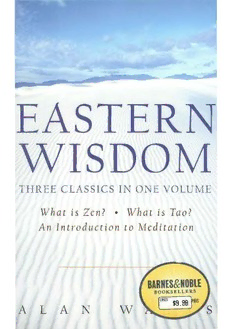
Eastern Wisdom: What Is Zen, What Is Tao, An Introduction to Meditation PDF
Preview Eastern Wisdom: What Is Zen, What Is Tao, An Introduction to Meditation
TI-IREE CLASSICS IN ONE VOLUME What is Zen? • What is Tao? An Introduction to Meditation BARNES&NOBLE BOOKSELLERS se) ss [°NIX $9. w A L A N E A S T E R N I S D O INCLUDES What is Zen? • What is Tao? A Introduction to Meditation A L A N W A T T S An Introduction to Meditation has also been published as Still the Mind. MJFBOOKS NEWYORK I Published by MJF Books Fine Communications Two Lincoln Square 60 West 66th Street New York, NY I 0023 Eastern Wisdom LCCN 200 I 091577 ISBN 1-56731-491-0 What is Zen? Copyright © 2000 by Mark Warts What is Tao? Copyright© 2000 by Mark Watts An Introduction to Meditation Copyright© 2000 by Mark Watts An Introduction to Meditation has also been published under the title Still the Mind. Editors: Mark Watts, Marc Allen Text Design: Tona Pearce Myers Interior Calligraphy: Alan Watts In What is Tao?, the poems on pages v, 22, and 52 are from Tao Te Ching, by Lao Tzu, a new English version, with foreword and notes by Stephen Mitchell. Translation copyright© 1988 by Stephen Mitchell. Reprinted by permission of HarperCollins Publishers, Inc. This edition published by arrangement with New World Library All rights reserved. No part of this publication may be reproduced or transmitted in any form or by any means, electronic or mechanical, including photocopy, recording, or any information storage and retrieval system, without the prior written permission of the publisher. Manufactured in the United States of America on acid-free paper ro MJF Books and the MJF colophon are trademarks of Fine Creative Media, Inc. BG 10 9 8 7 6 5 4 3 2 1 WHAT IS ZEN? ALAN WATTS "Each one of you is perfect as you are. And you all could use a little bit of improvement.)) - Suzuki Ros hi, founder San Francisco Zen Center CONTENTS Introduction by Mark Watts 1x Preface by Alan Watts x111 Part I A Simple Way, A Difficult Way 19 Part II Zen Reconsidered 31 Part III Space 61 Part IV Zen Mind 95 About the Author 125 INTRODUCTION By Mark Watts Zen is a method of rediscovering the experience of being alive. It originated in India and China, and has come to the West by way of Japan, and although it is a form of Mahayana Buddhism, it is not a reli gion in the usual sense of the word. The aim of Zen is to bring about a transformation of consciousness, and to awaken us from the dream world of our end less thoughts so that we experience life as it is in the present moment. Zen cannot really be taught, but it can be trans mitted through sessions of contemplation or med itation, called zazen, and through dialogues between student and teacher, called sanzen. In the ix What Is Zen? dialogue between the student and Zen master the student comes squarely up against the obstacles to his or her understanding and, without making the answer obvious, the master points a finger toward the way. Zen has enjoyed an increasing popularity in Western literature. D. T. Suzuki's book Outlines of Mahayana Buddhism was first published in the English language in 1907, and authors R. H. Blythe, Christmas Humphries, and Alan Watts all made early contributions to Zen literature in the West. Alan Watts wrote his first booklet on Zen in 1933, followed by his first book, The Spirit of Zen, in 1936 at the age of twenty--one. He moved from London to New York in 1938, and after spending nearly ten years in the Anglican Church headed west to California in 1950, where he began to teach Eastern thought at the American Academy of Asian Studies in San Francisco. There he met Japanese artist Sabra Hasegawa and beat poets Gary Snyder and Allen Ginsburg. His classroom lectures spilled over into the local X Introduction coffeehouses, and in 1953 he began weekly live radio talks on Pacifica station KPFA in Berkeley, California. Early radio series included "The Great Books of Asia" and "Way Beyond the West," which were later rebroadcast on KPFK in Los Angeles. In 1955 he began work on The Way of Zen with the help of a Bollingen grant arranged by Joseph Campbell, and following publication in 1957 he went to New York on the first of many cross-country speaking tours that continued over the next fifteen years. The selections for What Is Zen? were drawn from his later talks, given after he had studied and prac ticed Zen for many years. Most of the material is from recordings made during weekend seminars in which Watts reconsidered Zen with a small group aboard his waterfront home, the ferryboat SS Vallejo, in Sausalito, California. Instead of focusing on the historical back ground of Zen, he pr~sented the subject directly, in a way he felt would be most accessible to his pri marily Western audience. The result is a unique and effective example of the sanzen dialogue in practice, and although the words were delivered to XI What Is Zen? a group, the individual's psychological hurdles are addressed with uncanny sensitivity to the "mind traps" that typically confound students of Zen. In a delightful play of words, Watts's experi enced presentation gives us a healthy, heaping serv-- ing of the essential wisdom one discovers with the experience of Zen, and points a finger towards the way. xii
